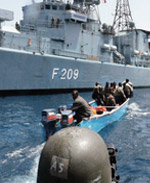
Obstacles to global shipping: Piracy and terrorism
 8.5 > Revered privateer: Sir Francis Drake (1540 to 1596) was considered a hero by the English, but a pirate by the Spanish for his raids on their trading ships. In 1581 he was knighted by the English crown.
8.5 > Revered privateer: Sir Francis Drake (1540 to 1596) was considered a hero by the English, but a pirate by the Spanish for his raids on their trading ships. In 1581 he was knighted by the English crown.The return of the buccaneer
As globalization progressed during the 1990s, pirate ships again appeared on the horizon, more than a century after their virtual disappearance. Piracy is an age-old maritime phenomenon, often sanctioned by the state, and in some cases it is even a highly respected profession. The English crown certainly welcomed the treasures explorer Sir Francis Drake (1540 to 1596) brought back from his raids on Spanish trading ships. Privateering was formally abolished by the Paris Declaration respecting Maritime Law issued on 16 April 1856. Now piracy is on the rise again, mainly off the coast of Somalia and the Gulf of Aden, i.e., along the major trade routes. Piracy frequently goes hand in hand with abject poverty, which drives people into this “line of business”. It is often boosted by the complete collapse of government order in the nations concerned. Piracy not only poses a threat to the crews of the ships and their cargo. It also makes maritime transportation more expensive. Shippers and ship-owners are feeling the costs of piracy quite substantially. The insurance premiums for a passage through the Gulf of Aden have increased more than tenfold, for example. The optional detour around the Cape of Good Hope takes weeks longer and uses much more fuel. Nevertheless, the risk of falling victim to a pirate attack is quite slim, even at piracy hotspots. Overall annual losses as a result of piracy in the straits are estimated to be 0.001 to 0.002 per cent of the total cargo value involved. According to experts, this amount is by no means alarming. The same applies to the current piracy hotspot, the Horn of Africa from the Somali coast to the Gulf of Aden, through which about 16,000 ships pass each year.
Terrorism – an incalculable risk
Since the terror attacks of 11 September 2001, the “worldwide threat to shipping” has become an increasingly significant topic. The International Maritime Organization (IMO) has adopted a number of binding security measures. The USA has taken the most drastic precautions, including the monitoring of containers during loading and along the entire transport chain. The United States’ most important trading partners comply with these measures to prevent problems with container traffic. On the one hand they are designed to prevent terrorists at sea from acquiring supplies of weapons and materials, and on the other, to avoid ships being hijacked and used as weapons themselves – like the aircraft used in the 9/11 attacks.
- 8.6 > Modern piracy: Following a steep increase in piracy at the start of this century, the number of attacks has now declined again worldwide. The exceptions are the waters off East Africa, and particularly Somalia.

- Security is a huge challenge for container traffic. The maritime system of container transportation is complex, involving interactions between diverse stakeholders, industries, regulatory bodies, modes of transport, operations systems, legal frameworks and terms of liability. The European Conference of Ministers of Transportation (ECMT) maintains that all stakeholders are responsible for the safety of the container trade. One solitary breach of security can compromise the security of the entire logistics chain. In addition to seaport container terminals, other extremely vulnerable points are marshalling yards, street stops and parking areas.
- A number of studies have been carried out on the economic consequences of terrorism on maritime traffic, most of which relate to US American ports. Their aim is to determine the total material losses in the event of a terrorist attack and subsequent port closures. Simulations, for instance, were used to calculate the economic damage of an attack on the port of Los Angeles with a radioactive “dirty bomb”. As a result of the attack all US ports would be closed for a week; clearing the resultant container congestion would take 92 days. The overall damage is estimated to be USD 58 billion. This purely economic study did not take into account the number of people who could potentially be killed or the damage to buildings. The consequences would nonetheless be disastrous.
- If it were to occur in one of the world’s largest ports (to compare container turnover in 2007: Los Angeles handled 8.4 million TEUs, Hamburg 9.9 million TEUs and Singapore 27.9 million TEUs) the impact would be even more severe. However, as yet there are no reliable estimates of likely preventative costs or how these stack up against the potential damage of terrorist attacks.
 8.7 > For fear of pirate raids, big guns are deployed in the Gulf of Aden. Japanese marines are among those hunting the freebooters. During a manoeuvre, the destroyer “Ikazuchi” goes alongside the supply vessel “Mashu”.
8.7 > For fear of pirate raids, big guns are deployed in the Gulf of Aden. Japanese marines are among those hunting the freebooters. During a manoeuvre, the destroyer “Ikazuchi” goes alongside the supply vessel “Mashu”.- Preventative costs include the purchase of specific equipment to monitor cargo shipments (such as X-ray facilities) and the assignment of very highly qualified personnel. On the one hand private stakeholders such as the shipping companies themselves invest in such security measures. On the other, countries stipulate certain requirements. The OECD has estimated the initial cost to shipping companies for implementing the security measures at USD 1.3 billion, and subsequently USD 730 million a year. These increased costs are reflected in higher prices and/or lower profit margins, at least in the short term, and thus tend to decrease maritime traffic. Then again, the measures could in the long term help to reduce costs in various ways – by cutting delays and speeding up processing times, for instance. It is also conceivable that the improved monitoring in handling and loading equipment, the greater use of IT and resulting lower personnel costs, fewer thefts due to improved security, and the lower insurance premiums as a result of greater security could cut costs in the long run. In spite of these potential reductions, experts believe that overall the higher security standards have driven up transport costs substantially. The OECD estimates that the threat of terrorist attacks in the United States has cancelled out about half the productivity gains in logistics of the past 10 years. Fears have even been voiced that the permanent terrorist threat is compromising the entire globalization process of the past 3 decades. The consequences to the organization of production are not so easy to quantify at present. Will it be possible to maintain just-in-time production in the future? As an initial reaction to insecurity caused by the terrorism threat, some manufacturers no longer rely only on just-in-time consignments.
The price of fear
A comprehensive economic analysis of the overall costs and gains of the security measures has yet to be carried out. The question at what stage the cure becomes more costly than the disease cannot yet be answered. Nobody knows exactly when the costs of the extra safety will surpass the costs of potential damage and devastation caused by actual terror attacks. Nightmare scenarios of hijacked ships being blown up and triggering gigantic explosions in vital ports cannot be completely ruled out, but are considered by experts to be extremely unlikely.